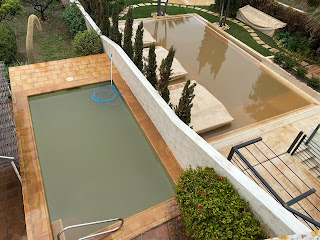The Road to, and from, Almeria
One of the most hellish episodes of the Spanish Civil War, among very many such episodes, was the bombing and strafing of the thousands of refugees fleeing from the Nationalist (Francoist) takeover of Malaga in early 1937. The refugees were trying to reach the relative but temporary safety of Almeria, about 200k east of Malaga on the same south coast. The route between the two cities was the old N340 coast road, vulnerable not only to air attack but also to bombardment from the sea. Estimates of casualties vary wildly, but they were certainly in the thousands. The death dealers were mainly Italian and German warplanes and gunships.
A road journey from Nerja (a short battlestop on the retreat in 1937) recalls those tragic times. These days, there’s the A7 motorway, which bludgeons through mountains and across steepling viaducts. But, just to the south, the modern edition of the N340 still runs along the coast, and nearby remnants of the old road are still be seen from time to time, marked by decayed tarmac and now decrepit bridges. Recently, some of these stretches have been commemorated by simple upright waymark posts engraved with the word “desbanda” – “retreat” (there’s one by the old bridge near Maro on the outskirts of Nerja).
An old road and its bloody history might be ghost enough on the journey east. But there are also modern sinister shrouded presences. Beyond Motril, an unassuming town once distinguished by its sugar cane industry, the landscape fills (and that is meant literally) with square kilometres of plastic canopies of so-called greenhouses. There is no such thing as open-air agriculture in these places.
If you had been asleep on your bus, you would be forgiven, on waking, for supposing that snowfall had come between the mountains and the sea- every feature of the landscape is white. Then you notice that the bus’s external temperature monitor is showing 20c or more…
The structures are indeed sinister. They are very large, of all geometric shapes, crammed together. Opaque (to the eye) white roofs are supported by tightly meshed black walls. There’s no telling what crops grow within, unlike in the ramshackle structures found in the campo further west. There are access tracks, but no visible human beings.
But we know that there are many people working inside the structures in pretty appalling conditions. They are mostly African migrants, without papers. “Without papers” means no rights.
The town of EL Ejido is at the epicentre of this strange and creepy economy. Our bus stopped there, after negotiating endless anonymous streets. Black passengers boarded or got off. The streets were otherwise mostly empty.
But here’s a weird thing. The empty unattractive streets host an enormous number of large aggressively signed car dealerships. Every upper-mid marque manufacturer is represented.
Who patronises these showrooms? Probably not the African migrants. Money is being made by enough other people to sustain the auto consumerism. God knows where the well-off live – there’s no room for houses amidst the plastic.
Perhaps in Almeria itself. A city with a big working port, some grand boulevards and modest but attractive centre – but without the elegance of Malaga.
Our hotel was in a C19 square dominated by a monument to some brave souls that tried to instigate an uprising against the despotic King Ferdinand in the 1820s. They were captured and shot. A similar monument stands in Malaga to another such failed adventure, with similar fatal outcome, in the 1830s.
That evening, a certain sepia tint was invading the sky. We did not notice it when visiting the brutal C16 cathedral, built as half church and half fort with gun emplacements (against pirates). Inside there’s the overpowering iconography of the Spanish Counter Reformation, all set in a splendidly constructed nave.
The next morning the sepia had become a pervading yellow fog. A vast Saharan dust cloud had arrived.
It was a day to be thankful to have masks at hand. We struggled up to Almeria’s great Alcazaba palace/ fortress, a good rival to Granada’s Alhambra, had it not been ruined by war and neglect, both medieval and modern. But it is still impressive in size and ruins. Some parts, especially terraced gardens have been well restored.
And the view over the City and port! Or the alleged view.. that day the view was of yellow smog.
Later that afternoon, the return bus journey was through dust cloud gloom, hiding both coast and plastic.
On arrival in Nerja, steady rain began, and continued overnight. This cleared the skies somewhat but covered buildings and filled swimming pools with orange slush.
March 2022












No comments:
Post a Comment